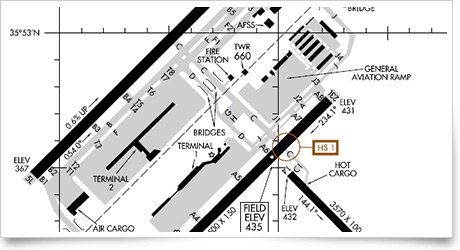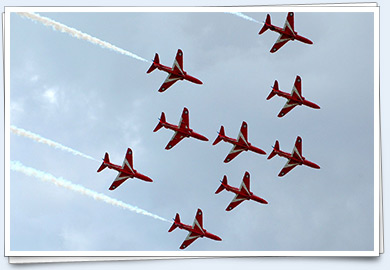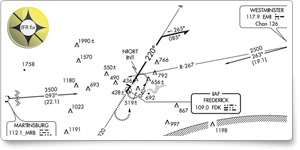Sept. 07, 2012, issue of 'AOPA ePilot: Flight Training Edition' weekly newsletter
| ||||||
| Two runways, same numbers |
| |||||
Training TipsTwo runways, same numbers
One airport layout that is important to understand because of its unique operating considerations (including a new twist for your communications) is an airport with parallel runways. Because the runway numbers are identical, it becomes necessary to make clear whether you are taking off or landing, for example, on Runway 19L (left) or Runway 19R (right). Be sure to include that information in your radio transmissions.
Chapter 4-3-3 of the Aeronautical Information Manual presents and illustrates general traffic-pattern operating procedures for airports with parallel runways. Note the importance of avoiding a traffic pattern that might penetrate the approach or departure path of the other runway.
With Runways 05L-23R and 05R-23L separated by airport terminal buildings, Raleigh-Durham International Airport is an example of a major airport with parallel runways.
A general aviation airport can have a parallel-runway layout, too—such as this one in Manassas, Va., with 5,700-foot-long and 3,704-foot-long runways.
Check details of airport operations carefully before you head for a parallel-runway destination. For example, it is right traffic for Runway 01R-19L at the recently opened Brunswick Executive Airport in Maine, a former naval air station. A careful reading of the airport's listing in the airport/facility directory contains this message about the other parallel runway: “Rwy 01L–19R CLOSED indef.” For added situational awareness, print out a copy of your destination airport's taxiway diagram and carry it on your kneeboard.
Busy airports may have arrivals and departures taking place simultaneously on parallel runways. If you are on final approach to Runway 23R, be sure to stay situationally aware of operations on Runway 23L. Is there a possible wake turbulence hazard?
An airport can have more than two parallel runways, in which case the letter C (center) follows the runway number, such as Runway 17C-35C at Dallas/Fort Worth International Airport.
It may be some time before you come face to face with the need to operate at an airport with parallel runways. Getting some early practice learning their unique requirements will help you be ready when the time comes. Flight Training NewsNFlightcam launches Solo Hall of FameNFlightcam—the company that customizes high-definition Contour video cameras for aviation use—is launching a program that allows student pilots to record their initial solo flights free on an NFlightcam, send them to the company for editing, and share the finished products via email, YouTube, and Facebook. Read more >> Ninety-Nines post 2013 scholarshipsThe International Association of Women Pilots (The Ninety-Nines) is accepting applications for the 2013 Amelia Earhart Memorial Scholarships and Awards. Scholarships are available for certificated pilot members to advance in training and education in aviation and aerospace, including scholarships to complete additional certificates and ratings, type ratings, college degrees, technical training, and emergency maneuver training. A New Pilot Award will provide $2,000 to the recipient toward a sport, recreational, or private pilot certificate. Applications are due Dec. 20. For more information, see the website. Eastern Michigan aviation program names new directorEastern Michigan University, Ypsilanti, Mich., has tapped Chris Sorenson to be director of operations and chief flight instructor at its aviation program. Sorenson, an EMU alumnus, will run ground schools and manage day-to-day operations at the college’s Eagle Flight Center, which operates out of Willow Run Airport in Detroit and a satellite operation at Capital Region International Airport in Lansing. EMU’s aviation program offers bachelor’s degrees in aviation flight technology, aviation management, and dispatch certification. ‘Flying for a Lifetime’ fall safety seminar debutsYou pay close attention to your airplane, search out hidden problems, and generally keep a wary eye on things—because, after all, airplanes change as they age. So do pilots. These changes can be subtle—but do you give them the attention they really deserve? Join the Air Safety Institute in a fun, fast-paced look at how to maintain a high level of safety for every flight in your life. Check seminar dates and locations near you. Top five reasons to catch AOPA's Parade of PlanesAOPA’s Parade of Planes returns after six years. Watch as dozens of aircraft taxi under their own power from Palm Springs International Airport to the Palm Springs Convention Center on Oct. 10. Here are the top five reasons you won’t want to miss this parade. Read more >> Arizona State University adds King Air simulatorArizona State University’s College of Technology and Innovation has acquired an Elite King Air advanced aviation training device. The AATD features dual electronic flight information systems (EFIS), a Garmin GNS 530 WAAS GPS, and a high-definition worldwide visual scenery database. It allows an instructor to simulate cabin depressurization, engine fires, engine power loss and failure, hot and hung starts, and GPS receiver autonomous integrity monitoring (RAIM) failures. ASU’s aviation program also has Frasca CRJ200, single engine, and twin/single engine flight training devices, a CAE full flight simulator, and a CAE CRJ-100/200/700/900 simulator. Flight school opens at Pennsylvania airportCargill Aeronautical Academy held an open house Aug. 25 at Capital City Airport in Harrisburg, Pa. The flight school offers training for the private, commercial, flight instructor, and flight instructor-instrument certificates, as well as for the instrument rating. The fleet includes two Cessna 172s, a Piper Cherokee, a Socata Trinidad, a Diamond DA20 and Diamond DA40, and a Redbird flight simulator. What does ADS-B mean for you?Confused about the upcoming automatic dependent surveillance-broadcast (ADS-B) requirements? Not sure if they apply to you? Take the newest online course from the Air Safety Institute, ADS-B for General Aviation: The Basics , and find out what this new technology means to the way you fly. Learn the basics on how it works, who is affected by its implementation, and the benefits of flying with ADS-B. Armed with the right information, you’ll be able to take advantage of the information ADS-B has the potential to give you. Training ResourcesYou know about the dangers of walking near spinning propellers. But there are other hidden obstacles and hazards lurking while you and your passengers navigate to and from hangars and tiedown spots. Even a simple walk around the aircraft can cause someone to trip over a tiedown rope or walk into sharp surfaces like wing trailing edges or pitot tubes. Download the Air Safety Institute’s Ramp Operations safety brief before your next flight for a quick refresher on the rules of the ramp.
Did you know that student pilots who join AOPA are three times more likely to complete their flight training? Membership includes unlimited access to aviation information by phone (800/USA-AOPA, weekdays from 8:30 a.m. to 6 p.m. Eastern time) or from Flight Training Online or AOPA Online. If you’re not already a member, join today and get the pilot’s edge. Login information is available online. Velocity’s V-Twin Career PilotFirst Gateway graduates seated in JetBlue cockpitsA four-way collaboration between JetBlue Airways, Cape Air, the University of North Dakota, and Embry-Riddle Aeronautical University has paid off for two pilots who recently joined JetBlue as first officers. Shanti Merriman and Daniel Thurber, both Cape Air captains and Embry-Riddle graduates, passed the JetBlue interview and report for duty in a few weeks, Cape Air announced Aug. 23. The University Gateway Program was started four years ago as a pipeline with clearly delineated steps that take young pilots from Aviation Accreditation Board International-approved programs through internships at Cape Air or JetBlue, undergraduate work with experience as flight instructors, and hands-on flying at Cape Air. Allegiant Air pilots vote to join TeamstersPilots at Allegiant Air have voted to join the Airline Professionals Association, Teamsters Local 1224 in Wilmington, Ohio, the Teamsters Airline Division announced Aug. 23. The approximately 350 pilots of Allegiant Air—a subsidiary of Las Vegas-based Allegiant Travel Company—fly McDonnell Douglas MD-80 and Boeing 757 aircraft. Teamsters Local 1224 now represents flight-crew members employed by ABX Air, Allegiant Air, Atlas Air, Cape Air, Horizon Airways, Kalitta Air, Miami Air, Omni Air International, Silver Airways, and Southern Air. Plane SpotterCirrus SR22: Fixed gear, but fast Training ProductsCloudAhoy app lets you debrief each flightWondering how your ground track looks on a turn around a point, or if that ILS approach was as flawless as it felt in the air? A free app called CloudAhoy collects flight data as you fly, and then lets you debrief the flight on the ground. You’ll need to create an account with CloudAhoy, and then download the app, currently supported by iOS. (You can use the app on up to four devices with the same account, and you’ll also need an external GPS if your device doesn’t have one.) Start the app before you start the engine; allow it to transmit the data to the CloudAhoy server after the flight. Then log in to your account and the flight is ready for your review. For more information, see the website. Note: Products listed have not been evaluated by ePilot editors unless otherwise noted. AOPA assumes no responsibility for products or services listed or for claims or actions by manufacturers or vendors. Member BenefitsTesting the limitsThe most important coverage on your policy is often the most misunderstood: aircraft liability limits. You hear us banter around insurance terms such as smooth limits, combined single limit, sublimits, per passenger versus per person, et cetera. What does it all mean? Read more >> Frequent headaches?Pilots must answer whether they have a history of “frequent or severe headaches” on their medical application. But what, exactly, constitutes a frequent or severe headache? Is three headaches a month frequent, or three a year? How do we determine severity? On a scale of one to 10, which is how your doctor would normally ask you to gauge the pain? Or how often you have to take medications to stop the headache? Find out what the FAA says in this latest installment from AOPA’s Pilot Protection Services. Read more >> BlogsDon't forget the logbooks! And other useful checkride tipsFlight Training Facebook readers share the most helpful tips they received before taking a checkride. Also in the Flight Training blog, Chip Wright discusses the factors that a professional pilot has to consider when pondering the move from first officer to captain. Stuff your CFII may not have told youAOPA Foundation President Bruce Landsberg says he learned a lot of practical lessons about instrument flying after he earned the rating—such as the fact that weather is what you find, not what is forecast. In this week’s Leading Edge blog, he asks for your submissions for an upcoming presentation at AOPA Aviation Summit in Palm Springs, Calif. AOPA Career OpportunitiesEver dream of turning your passion for aviation into a career? We’re looking for a director of media relations, director of legislative affairs, major gifts officer, accounts payable technician, administrative coordinator, aviation technical generalist, and Web graphic designer. To learn more about other AOPA career opportunities, visit AOPA Online. Community
AVIATION EVENTS & WEATHER
| ||||||||||||||||||||||||||||||||||||




 When a student pilot ventures forth on those first cross-country flights, it quickly becomes obvious that all those airports out there present an endless variety of runway layouts, lengths, widths, and procedures for arriving and departing. From obstacles on final to nonstandard traffic pattern altitudes or right-hand traffic, your destination airports broaden your terminal-area experience and enhance your general operating knowledge and confidence.
When a student pilot ventures forth on those first cross-country flights, it quickly becomes obvious that all those airports out there present an endless variety of runway layouts, lengths, widths, and procedures for arriving and departing. From obstacles on final to nonstandard traffic pattern altitudes or right-hand traffic, your destination airports broaden your terminal-area experience and enhance your general operating knowledge and confidence.





